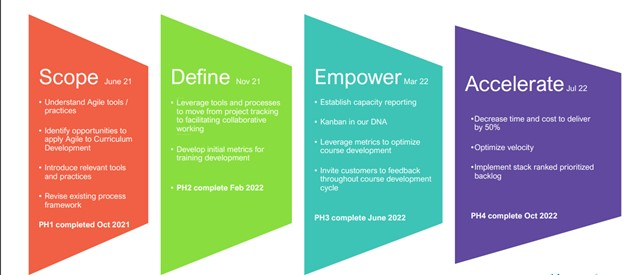A recent CEdMA workshop hit a familiar note. So many training departments are trying to keep up with the new features and functionalities being introduced by software engineering departments and they are failing.
The one presentation that was particularly impactful was the one offered by team at Blue Prism. Initially the organization used the traditional ADDIE approach – Analysis and Design, Development, Implementation, and Evaluation – but the team found that this approach wasn’t working for them. They needed an approach that not only allowed them to deliver courses that were of high value and quality, but also enabled them to deliver rapid training programs that aligned with the product’s general availability (GA) dates. They also needed an approach that would allow them the time to maintain and update their training offerings as well.
Identifying the challenges
At the beginning, the instructional design team and the curriculum development team were working in silos for most of the project. There wasn’t the necessary collaboration to ensure proper ownership of tasks.
The learning team at Blue Prism realized that they had to improve the team’s project and time management and ensure that the team worked smarter and faster, rather than just longer. They also felt that they needed to better track who was working on what and when. One of the issues felt by team members and is that they were worried that they may be “treading on somebody’s toes” or that a task was not in their job description.
Looking at the evaluation process, once training was delivered, they needed to consistently be doing reviews, performing evaluations, and acting on business and customer feedback. This led them to look for ways to innovate on their traditional process and tools.
Getting started with Agile methodology
To get the process started, the team got support and approval from their global leader of education services to commit to the transformation. They also spoke to other teams, like the product engineering teams, to understand what they could take from their existing Agile implementations and apply it to their own journey.
The next step was to put together an Agile project team within the education services department to discuss, plan, and identify their objectives. The team knew that they would not be able to implement all the changes at once, but they wanted to have a phased roadmap.
They leveraged several resources to help them make thoughtful decisions. First, they brought in Certified Scrum Masters and those who that have experience with agile curriculum development and Agile tools like Jira. They also reached out to organizations like Sigma and other industry experts and companies and asked for their experiences on their agile journeys.
Agile Roadmap
Blue Prism’s Agile journey has evolved since the project first started. After doing their research, getting feedback, and identifying their problem statements, they landed on the following roadmap:

The first phase involved
- Understanding Agile tools and practices
- Identifying opportunities to apply Agile to curriculum development
- Introducing relevant tools and practices
- Revising existing process framework
The team knew that they would not be able to implement all the changes at once, but they wanted to have a phased roadmap.
At the time of this presentation, the team had just completed Phase 2 which was about leveraging tools and processes to move from project tracking to facilitate collaborative working and developing initial metrics for training development. Essentially, the team was educated on Jira and defined what within curriculum development can be Agile. They answered questions like “Can we put instructor led training through Agile?”, and “Can we go Agile with video creation?”.
As part of the third phase, the team will start to look at metrics, evaluations, capacity, and management metrics. They are also going to start adding more and more into Jira and within their Agile process. For the final phase, the team is looking to decrease the time and cost to deliver projects using Agile by 50 percent.
Challenges identified
As part of the Agile introduction process the Blue Prism team identified many challenges that training developers often encounter including:
- A lot of waiting around for information from a subject matter expert for learning content for the eLearning course.
- Project creep
- Missed deadlines
By introducing reviews at each stage, the Blue Prism team was able to have faster handovers of information.
The introduction of Agile allowed them to start thinking about solutions on how to tighten up the process. The team started to include a review process at every single stage to look for opportunities like:
- Curriculum developer identifies what information they have right now for the senior instructional designer. This eliminated the need to create a scope for the entire course
- Modularize learning content development, not the classes. If you have a class that has 10 modules and you’ve got the information for modules 3 and 5, you start with those.
By introducing reviews at each stage, the Blue Prism team was able to have faster handovers of information. They were also able to have faster reviews of the actual content, which means that they didn’t have a massive review when they reached the end of a fully developed course.
Jira for rapid training content development
Initially the team was using tools like Microsoft Excel to track project completion. With Jira, the team was able to leverage the roadmap dashboard so they could see when projects were going to start and end and how they looked next to each other.
As team members started using the tool (Jira), the learning team was able to have a much better understanding of how long it took to complete some of the projects, and not just how much time had lapsed.
The team also used Jira to implement the framework using project types. For example, when they used the project type for eLearning, the tool would pre-populate that project with all the stages and the subtasks that are involved from initial analysis through to launching it on the LMS (learning management system).
This meant team members could see what individual tasks had been completed, what was the next task, and who was assigned to that task. It also enabled the team to embed into the project types approximations of how long it took to do each of the tasks within each stage.
As team members started using the tool, the learning team was able to have a much better understanding of how long it took to complete some of the projects, and not just how much time had lapsed. The tool also enabled teams to work on modules concurrently while other modules were in the analysis state.
Some of the other benefits of using Jira mentioned by the presenter included:
- More project collaboration
- Team members had a better understanding of their current and future workloads
- People felt more empowered to take ownership
- People could more easily plan their own individual roadmap for the products that they owned
From a manager’s perspective, the use of Jira enabled them to see where there may be bottlenecks in the process and where individuals might need some additional coaching, support, or training.
The presenter also noted that the output from a customer’s point of view was likely better because the team received constant feedback on very small pieces of information. And since the team was able to improve delivery, customers were also likely enjoying the benefits of more timely training.
Success metrics
The team at Blue Prism has piloted three projects with the new methodology and while it did reduce the time to deliver a course as they were able to work on courses concurrently, they found that it didn’t speed up the time it takes to build a course.
Using Agile for rapid course development has enabled the team so far to deliver 38 eLearning courses and 2 instructor-led training sessions (ILTs). The team also has another 13 eLearning projects in progress. As part of this initial phase, the team also has created six project types in Jira. For these project types, the system pre-populates the tasks with time taken and estimates.
Finally, the team was able to start to collate data about how long it takes us to produce each type of training output so that they can look for efficiencies in the future or targets that each team member should be working towards to be able to do this task in this amount of time.
Lessons learnt
This example demonstrates that while the process to be moving to Agile can take time, it has the potential for big rewards. The team at Blue Prism left these parting thoughts for any other company looking to move leverage Agile as their rapid course development methodology of choice:
- Be mindful and patient
- Create an open-door policy for help
- Never stop educating the team
- Speak Agile in all communications
- Continuously improve
- Don’t assume everyone will pick up at the same pace
- It takes time and effort to move from fixed to growth mindset
Final rapid content development tools reflection
While reflecting on the Blue Prism presentation it stood out to me that the results they achieved was more on managing the overall process and faster delivery of content but they still lacked a tool that could help them develop the content more quickly.
As industry experts in learning programs, we know there are bottlenecks in the course creation phase as you need to interview subject matter experts – which can take hours or days depending on how knowledgeable they are about the topic at hand and how busy they are. Then there is the bottleneck of translating their knowledge into content using word processing tools like Word or PowerPoint. It’s why we’ve chosen to innovate in this area specifically!
With our LEAi, you can now create instructor-led training (ILT), eLearning, knowledge base articles, virtual class content, presentations, webinars, videos using content your subject matter experts have already created and convert it into learning content in minutes, rather than days, weeks or months.
Key benefits of LEAi include:
- Use content that exists. Save time by leveraging assets that already exist.
- Be guided by best practices. Create courses that are going to be effective.
- Update courses fast. No longer spend months to update course content.
- Repurpose content easily. Deliver the same content in different courses easily.
- Choose how to deliver courses. Format content to meet your audience’s needs.
If you are in the market for a rapid content development tool or would like some advice on how to introduce rapid training programs, give us a call!

